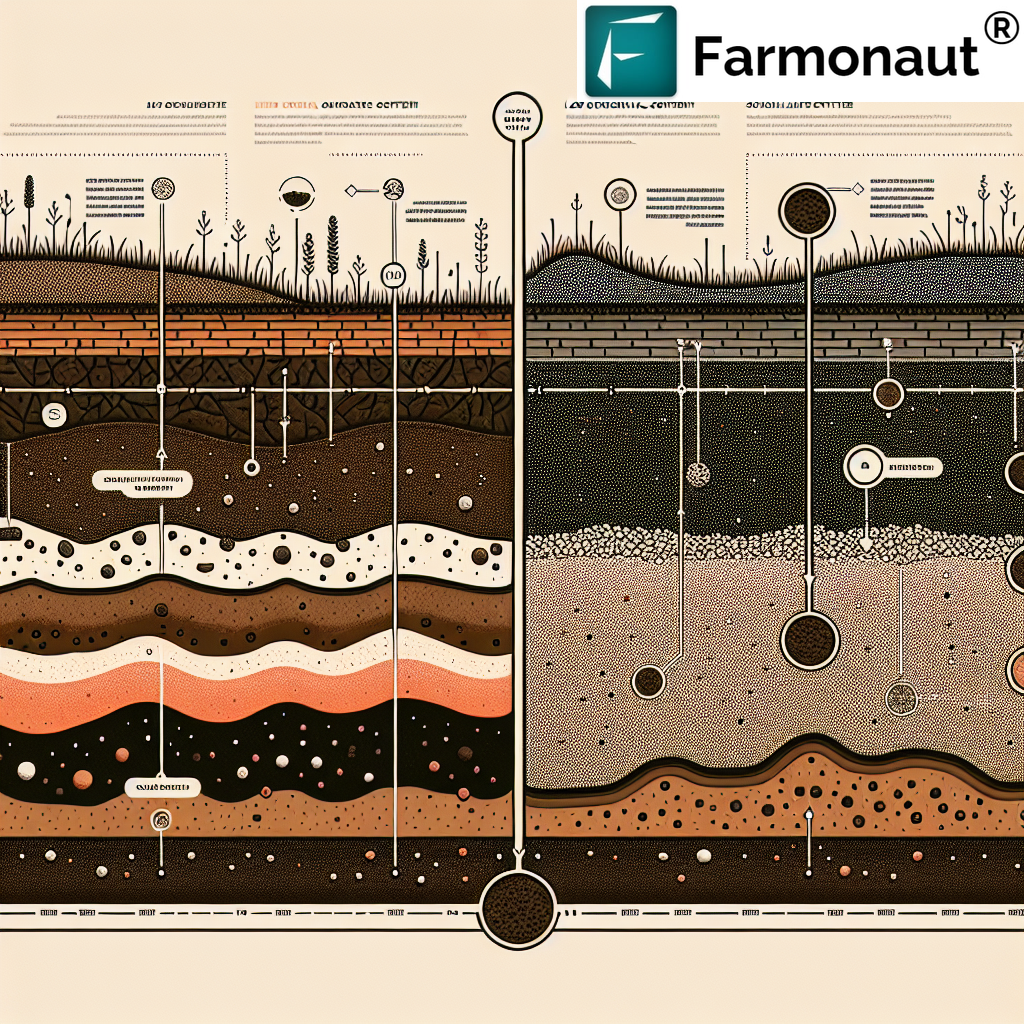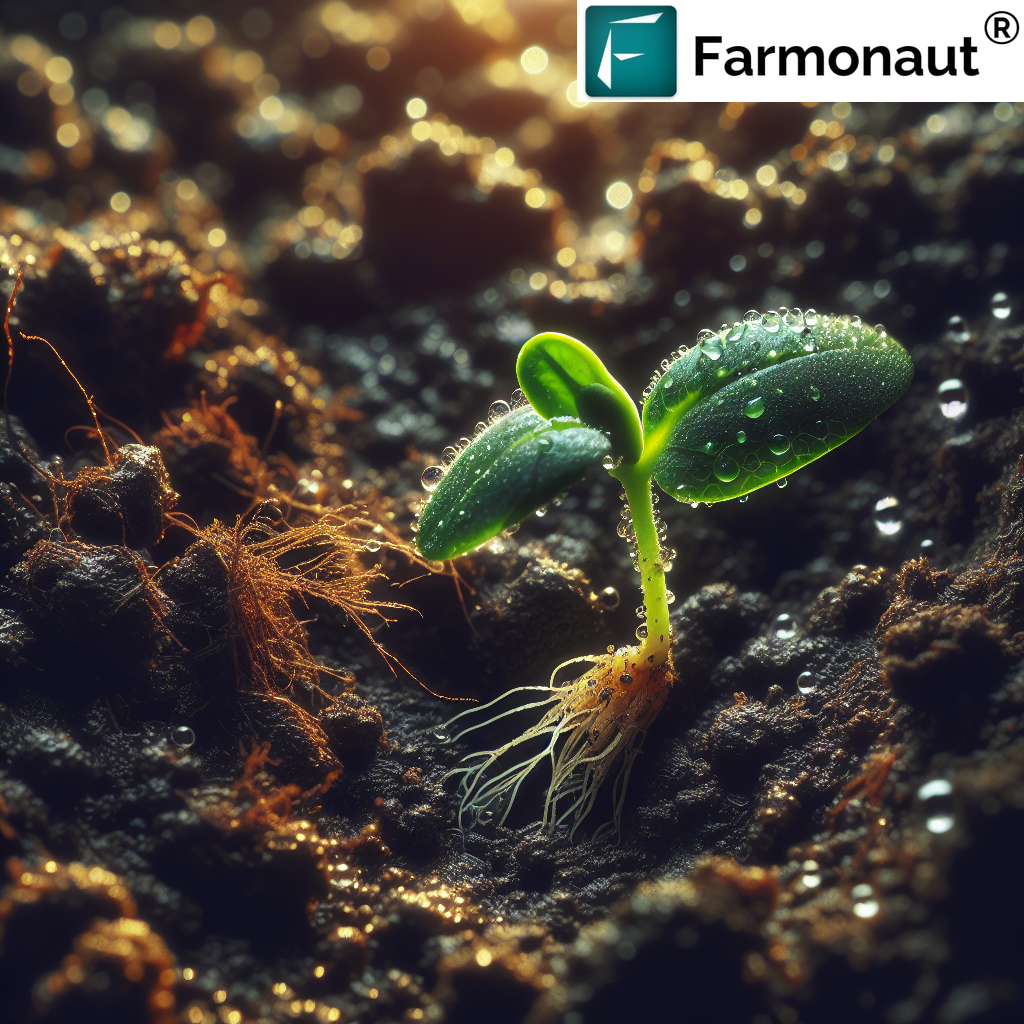Unlocking Plant Growth: The Vital Role of Soil Organic Matter Percentage in Agriculture

As agricultural experts and pioneers in satellite-based farm management solutions, we at Farmonaut understand the critical role that soil organic matter plays in plant growth and overall farm productivity. In this comprehensive guide, we’ll delve deep into the world of soil organic matter, exploring its properties, benefits, and optimal percentages for various crops. We’ll also discuss how our cutting-edge technology can help farmers optimize their soil management practices for maximum yield and sustainability.
Table of Contents
- Understanding Soil Organic Matter
- Properties of Soil Organic Matter
- The Ideal Percentage of Soil Organic Matter
- How Soil Organic Matter Affects Plant Growth
- Organic Soil Benefits
- Measuring and Monitoring Soil Organic Matter
- Strategies to Improve Soil Organic Matter Content
- Farmonaut’s Role in Soil Management
- FAQ Section
1. Understanding Soil Organic Matter
Soil organic matter (SOM) is a crucial component of healthy, productive soil. It consists of decomposed plant and animal materials, living microorganisms, and humus – the stable organic matter that results from the decomposition process. The properties of soil organic matter make it an essential factor in determining soil quality and fertility.
At Farmonaut, we recognize that understanding and managing soil organic matter is fundamental to sustainable agriculture. Our satellite-based monitoring systems provide farmers with valuable insights into their soil conditions, enabling them to make informed decisions about soil management practices.
2. Properties of Soil Organic Matter
The properties of soil organic matter contribute significantly to soil health and plant growth. Some key characteristics include:
- Water Retention: Organic matter can hold up to 20 times its weight in water, improving soil moisture retention.
- Nutrient Storage: SOM acts as a reservoir for essential plant nutrients, releasing them slowly over time.
- Soil Structure: It helps create a stable soil structure, improving aeration and root penetration.
- pH Buffering: Organic matter helps stabilize soil pH, creating a more favorable environment for plant growth.
- Microbial Activity: SOM supports a diverse and active soil microbial community, which is crucial for nutrient cycling and plant health.
Understanding these properties is crucial for effective soil management. Our Farmonaut platform provides detailed soil analysis, helping farmers track these essential characteristics over time.
3. The Ideal Percentage of Soil Organic Matter
One of the most common questions we encounter is, “What percentage of soil is organic matter?” or “What percent of soil is organic matter in a healthy system?” The answer can vary depending on soil type, climate, and land use, but generally:
- For most agricultural soils, a good soil organic matter percentage ranges from 3% to 6%.
- In natural, undisturbed soils, organic matter content can be as high as 10% or more.
- Sandy soils typically have lower organic matter content (1-3%), while clay soils can maintain higher levels (4-8%).
It’s important to note that even small increases in soil organic matter can have significant benefits for soil health and crop productivity. Our Farmonaut satellite monitoring system can help farmers track changes in soil organic matter over time, allowing for targeted management strategies.

4. How Does Soil Organic Matter Affect Plant Growth?
How does soil organic matter affect plant growth? The impact is profound and multifaceted:
- Nutrient Availability: SOM releases essential nutrients like nitrogen, phosphorus, and sulfur as it decomposes, providing a steady supply of nutrients to plants.
- Improved Water Retention: Higher organic matter content increases the soil’s water-holding capacity, reducing drought stress and improving irrigation efficiency.
- Enhanced Soil Structure: Organic matter helps create a crumbly soil structure that allows for better root growth and penetration.
- Increased Cation Exchange Capacity (CEC): SOM improves the soil’s ability to hold and exchange nutrients, reducing leaching and improving fertilizer efficiency.
- Microbial Activity: Organic matter supports a diverse soil microbiome, which can enhance plant growth through various mechanisms, including disease suppression and nutrient cycling.
- Temperature Regulation: Soils with higher organic matter content tend to warm up more slowly in spring but maintain more consistent temperatures throughout the growing season.
At Farmonaut, our satellite-based crop monitoring system can help farmers identify areas where plant growth may be impacted by suboptimal soil organic matter levels, allowing for targeted interventions.
5. Organic Soil Benefits
The organic soil benefits extend beyond just improved plant growth. They include:
- Increased Soil Biodiversity: Higher organic matter supports a more diverse and resilient soil ecosystem.
- Improved Soil Tilth: Organic matter enhances soil structure, making it easier to work and less prone to compaction.
- Reduced Erosion: The improved soil structure and increased water retention capacity help reduce soil erosion.
- Carbon Sequestration: Increasing soil organic matter is an effective way to sequester carbon, contributing to climate change mitigation.
- Enhanced Nutrient Use Efficiency: Organic soils typically have better nutrient retention and cycling, reducing the need for synthetic fertilizers.
- Improved Water Quality: By reducing runoff and increasing water infiltration, organic soils help improve local water quality.
Our Farmonaut platform includes features for tracking these benefits over time, helping farmers quantify the impact of their soil management practices.
6. Measuring and Monitoring Soil Organic Matter
Accurately measuring soil organic matter is crucial for effective soil management. Traditional methods include:
- Loss on Ignition (LOI): This method involves heating a soil sample to burn off organic matter and measuring the weight loss.
- Walkley-Black Method: A wet chemistry technique that measures the oxidizable organic carbon in the soil.
- Dry Combustion: The most accurate method, using specialized equipment to measure total carbon content.
While these methods provide accurate measurements, they can be time-consuming and expensive for regular monitoring. This is where Farmonaut’s satellite-based monitoring system offers a significant advantage. Our technology allows for:
- Regular, non-invasive monitoring of soil conditions
- Detection of spatial variations in soil organic matter across fields
- Tracking changes in soil organic matter over time
- Integration with other crop health indicators for comprehensive farm management
By combining satellite data with ground-truth measurements, we provide farmers with a powerful tool for ongoing soil health monitoring.
7. Strategies to Improve Soil Organic Matter Content
Improving soil organic matter content is a long-term process, but it’s crucial for sustainable agriculture. Some effective strategies include:
- Cover Cropping: Planting cover crops during fallow periods adds organic matter and protects the soil.
- Crop Rotation: Diversifying crops can improve soil structure and organic matter content over time.
- Reduced Tillage: Minimizing soil disturbance helps preserve existing organic matter and promotes accumulation.
- Compost and Manure Application: Adding well-decomposed organic materials directly increases soil organic matter.
- Residue Management: Leaving crop residues on the field after harvest contributes to organic matter buildup.
- Biochar Application: This stable form of carbon can improve soil properties and increase organic matter content.
Our Farmonaut platform can help farmers track the effectiveness of these strategies by monitoring changes in soil health indicators over time.
8. Farmonaut’s Role in Soil Management
At Farmonaut, we’re committed to helping farmers optimize their soil management practices through advanced technology. Our satellite-based monitoring system offers several advantages over traditional methods:
| Feature | Farmonaut Satellite System | Drone-based Monitoring | IoT-based Monitoring |
|---|---|---|---|
| Coverage Area | Large scale (entire farms) | Limited by flight time and regulations | Limited by sensor placement |
| Frequency of Data Collection | Regular (every few days) | As needed, but labor-intensive | Continuous, but spatially limited |
| Cost-effectiveness | High | Medium | Low for large areas |
| Data Integration | Comprehensive farm-wide data | Limited to flight areas | Limited to sensor locations |
| Ease of Use | User-friendly interface, no on-site work required | Requires trained operators | Requires installation and maintenance |
Our system provides farmers with:
- Regular updates on soil health indicators
- Early detection of soil degradation issues
- Precision agriculture recommendations based on spatial variability
- Integration with weather data for optimal resource management
- Long-term tracking of soil improvement strategies
To learn more about how Farmonaut can help you optimize your soil management practices, visit our app page or explore our API documentation.
9. FAQ Section
Q: What is a good soil organic matter percentage?
A: A good soil organic matter percentage typically ranges from 3% to 6% for most agricultural soils. However, the ideal percentage can vary depending on soil type, climate, and crop requirements.
Q: How does soil organic matter affect plant growth?
A: Soil organic matter affects plant growth by improving nutrient availability, water retention, soil structure, and microbial activity. It also helps regulate soil temperature and pH, creating an optimal environment for root development and overall plant health.
Q: What are the main organic soil benefits?
A: Organic soil benefits include improved soil structure, increased water-holding capacity, enhanced nutrient retention and cycling, reduced erosion, increased soil biodiversity, and improved overall soil health and fertility.
Q: What are the key properties of soil organic matter?
A: The key properties of soil organic matter include its ability to retain water, store and release nutrients, improve soil structure, buffer pH changes, and support soil microbial communities.
Q: What percent of soil is typically organic matter?
A: The percentage of soil that is organic matter can vary widely, but typically ranges from 1% to 6% in agricultural soils. Natural, undisturbed soils may have higher percentages, sometimes exceeding 10%.
Q: How can I increase the organic matter in my soil?
A: You can increase soil organic matter by implementing practices such as cover cropping, crop rotation, reduced tillage, adding compost or manure, proper residue management, and using biochar. Consistent application of these practices over time will gradually build up soil organic matter.
Q: How often should I test my soil’s organic matter content?
A: It’s generally recommended to test soil organic matter content every 3-5 years. However, with Farmonaut’s satellite monitoring system, you can track changes in soil health indicators more frequently and non-invasively.
Q: Can too much organic matter be harmful to soil?
A: While rare in agricultural settings, extremely high levels of organic matter (above 10%) can potentially lead to issues such as excessive nitrogen release or water retention. However, for most agricultural soils, increasing organic matter content is beneficial.
Q: How long does it take to see improvements in soil organic matter?
A: Improving soil organic matter is a long-term process. Noticeable improvements typically take 3-5 years of consistent management practices, but the full benefits may not be realized for a decade or more.
Q: How does Farmonaut help in managing soil organic matter?
A: Farmonaut’s satellite-based monitoring system provides regular updates on soil health indicators, allowing farmers to track changes in soil conditions over time. This data helps in making informed decisions about soil management practices and evaluating the effectiveness of organic matter improvement strategies.
Conclusion
Understanding and managing soil organic matter is crucial for sustainable and productive agriculture. As we’ve explored, the percentage of organic matter in soil plays a vital role in plant growth, soil health, and overall farm productivity. By leveraging advanced technologies like Farmonaut’s satellite-based monitoring system, farmers can gain valuable insights into their soil conditions and make data-driven decisions to optimize their soil management practices.
We invite you to explore how Farmonaut can help you in your journey towards healthier soils and more productive farming. Download our app today:
For developers interested in integrating our soil monitoring capabilities into their own applications, check out our API documentation.
Ready to take the next step in optimizing your soil management? Subscribe to Farmonaut today:
By harnessing the power of satellite technology and data-driven insights, we can work together towards a more sustainable and productive agricultural future.
